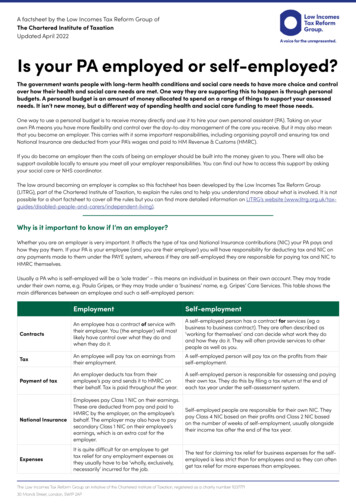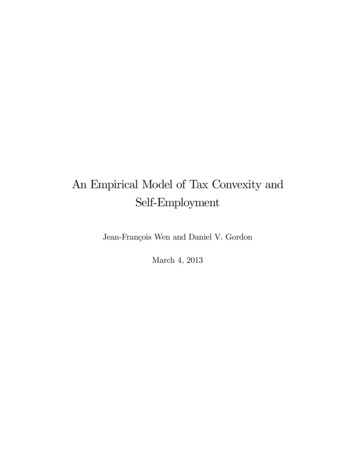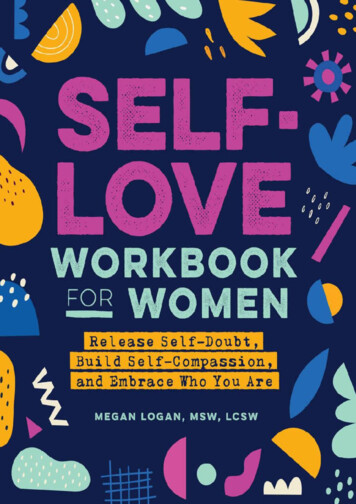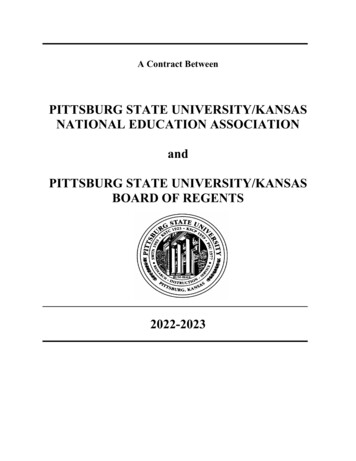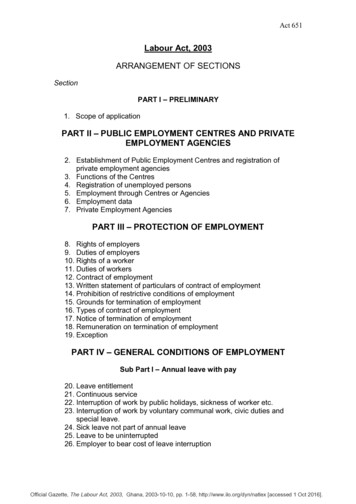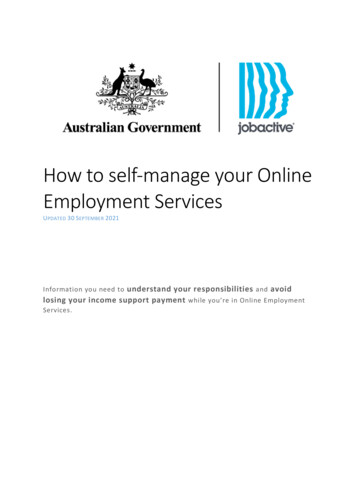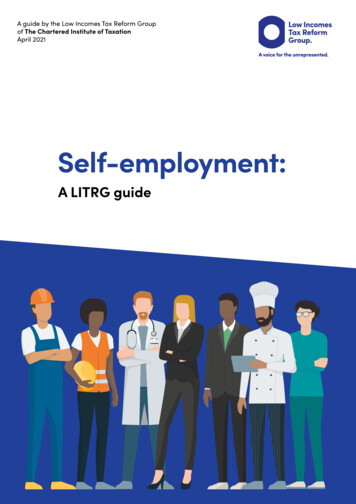
Transcription
A guide by the Low Incomes Tax Reform Groupof The Chartered Institute of TaxationApril 2021Self-employment:A LITRG guidepage 1Self-employment: A LITRG guide
Who is this guide for?This guide is intended to supplement the material in the self-employment section of theLITRG website. We wrote this guide to help self-employed people who want detailedinformation in one accessible place and non-specialist advisers who help low-incomeself-employed individuals.The guide is split into two parts: the first considers the main areas that concern mostself-employed people with straightforward tax affairs and also covers in greater detailmore complex areas which may arise – for example, if you are claiming certain statebenefits or have additional tax obligations such as registering for the ConstructionIndustry Scheme (CIS) section from page 8. The second part includes general usefulinformation such as advice on contacting HMRC, important tax deadlines and checklists.Please note the guide is written from the perspective of addressing the self-employedindividual rather than their adviser.Throughout this guide, you can find details of other organisations who may be able tohelp you further.Some of the information in this guide may be new to you and can be quite technicalin nature. We have tried to simplify things as much as possible and have included toptips to help you deal with self-employed tax affairs. We have included a case study toillustrate how to prepare business accounts and Self Assessment tax return on page 33,and a glossary from page 74 that explains some of the terms used in the guide.The coronavirus (COVID-19) outbreak has resulted in some temporary changesto tax and benefits rules which may affect the self-employed including how tocomplete your 2020/21 tax return. There is detailed information about thesechanges on the LITRG website. In this guide we have highlighted where temporaryrule changes apply with this symbol .page 2Who is this guide for?Self-employment: A LITRG guide
ContentsIntroduction 5Section 1First things first 6What is self-employment? 6What help is available with tax status (self-employed vs employed)? 7What are your tax and National Insurance responsibilities if you are self-employed? 7How and when should you notify HMRC that you are self-employed? 8What happens after you have registered with HMRC? 8How do you register under the Construction Industry Scheme? 9Starting to trade 10What type of business are you setting up? 10What business records do you need to keep? 11Why do you need to prepare accounts? 11What important things do you need to consider when preparing your accounts? 12Special rules for calculating profits for certain trades and businesses 18How to complete your Self Assessment tax return 19What tax allowances, reliefs and other deductions are available? 22When do you pay any income tax due? 24Tax losses 27What National Insurance contributions do you pay? 28Special circumstances for calculating National Insurance contributions 29Partnerships 30Checklist for starting a business 32Case study on how to prepare your accounts and Self Assessment tax return 33Growing your business page 343Taking on staff 43Registering as an employer with HMRC 44Reporting Pay As You Earn (PAYE) – the options 45ContentsSelf-employment: A LITRG guide
Contentscontinued Employment law 46National minimum wage 47Pension auto-enrolment (workplace pensions) 47What is Value Added Tax (VAT)? 47Registering for VAT 48VAT returns 48VAT schemes 49Local taxes 50Other things to consider as your business grows 52Stopping your business 53Notifying HMRC 53Stopping your business – if registered for PAYE or VAT 54Stopping your business – if claiming tax credits or universal credit 55State benefits 56Tax credits 56Universal credit 59Other state benefits 63Additional help for those with disabilities 65When things go wrong with your tax affairs 66Section 2Other useful things to know page 467Advice on how to contact HMRC 67Digital tax accounts and Personal Tax Accounts 68Websites for further information 68Organisations that might be able to help you further 68Further help and guides from HMRC 69Some important tax allowances and rates 70Some important tax dates 72Glossary: important words and phrases 74ContentsSelf-employment: A LITRG guide
IntroductionThe last ten years have seen a large rise in the number of people who are selfemployed,1 many of whom earn a low income, perhaps working in the ‘gig economy’ andunable to afford tax advice. Setting up a new business can be a daunting prospect and,for many, the complex tax and benefit rules are difficult to fully understand. Therefore,these people will often turn to other organisations to help them make sure they are bothfulfilling their obligations and receiving the benefits that they are entitled to.For the low-income self-employed worker there have been some important changesin the tax system in the last few years with the introduction of the trading allowance,cash basis, and simplified expenses, as well as temporary changes because of thecoronavirus outbreak, such as the Self-Employment Incomes Support Scheme, and thereare major changes expected over the next few years due to HMRC’s Making Tax Digitalprogramme. The first phase of the programme, Making Tax Digital for VAT, startedduring 2019 and Making Tax Digital for Income Tax is due to come in from April 2023.There are also significant changes taking place to the benefits system with the continuedroll-out of universal credit which is replacing tax credits and other benefits.We are also concerned that some of the information provided on GOV.UK is insufficientto enable people to fully understand their tax and benefits situation. There is lesspersonal help available from HMRC and a greater expectation that the self-employedwill be able to deal with their own tax affairs through online assistance rather than faceto-face help.As explained above, this guide has been written in two sections.The main part of this guide aims to answer the key questions that most self-employedpeople with straightforward tax affairs will have. Some sections of this guide will linkacross to the self-employment guidance and coronavirus guidance on our website.There are also parts of this guide which address more complicated tax and benefitissues that some low-income self-employed workers may face.The second part provides general information which may be useful to know about suchas tax deadlines, organisations that may be able to provide further help, and tax rates.1page 5Estimated at 4.8 million (Trends in self-employment in the UK) in 2017 which is approximately 15% of theUK workforceIntroductionSelf-employment: A LITRG guide
First things firstThis section explains what your responsibilities are from a tax perspective if you are selfemployed. We cover National Insurance contributions in our starting to trade sectionfrom page 10.It will address the following questions: Page 6: What is self-employment? Page 7: What help is available with tax status (self-employed vs employed)? Page 7: What are your tax and National Insurance responsibilities if you are selfemployed? Page 8: How and when should you notify HMRC that you are self-employed? Page 8: What happens after you have registered with HMRC? Page 9: How do you register under the Construction Industry Scheme?What is self-employment?A self-employed person is often described as running their own business or as a soletrader. You do not have a choice over whether to be treated as employed or selfemployed for tax purposes; it depends on the circumstances.It is important to realise that you may be neither employed nor self-employed if youare volunteering, training or gaining work experience, or undertaking an activity on aone-off basis. If you are a director of your own limited company then you are not selfemployed but an office holder and employee of your company.For many people their employment status will be straightforward. However, for somepeople the distinction between employment and self-employment is not as clear. Somebusinesses try to exploit this by treating people as self-employed when they should betreated as an employee. They do this to avoid operating Pay As You Earn (PAYE) andcomplying with employment law. In this situation, if HMRC believe the individual is anemployee, they could assess the taxpayer for the tax that would have been due if theyhad been taxed correctly as an employee – although HMRC should usually approachthe employer first.Be wary if:page 6 you are offered work and given a choice of being an employee or self-employed; or someone you are going to work for tells you that you are self-employed – in thiscase you should ensure you check this to confirm it is correct.First things firstSelf-employment: A LITRG guide
Top TipWe strongly recommend that you understand your employment status before you startwork. If you are self-employed you will have no entitlement to any employment rights,which include things like paid holidays and sick leave. You will also have to take fullresponsibility for your tax affairs.If you are uncertain about your employment status then we cover this area in greaterdetail on our page Am I employed, self-employed, both or neither? and in Furtherhelp and guides from HMRC from page 70. Be aware that the rules which are used forincome tax and National Insurance contributions differ from the guidance used for taxcredits and universal credit purposes. So, you need to make sure you refer to the correctguidance, depending on the situation.What help is available with tax status(self-employed vs employed)?If you think that something is wrong with your employment status so that your incometax and National Insurance contributions are not being dealt with on the right basis, youcould challenge the business that is offering you the work and ask them to put thingsright. However, this may affect your offer of work.If necessary, HMRC can help you determine whether you are employed or selfemployed by using their online tool called the Check Employment Status for Tax (CEST)tool. It will ask you a set of questions about your situation and it will then give you anindication of your employment status for tax. You can then print this off and show yourengager (the business that is offering you work).If all else fails and you think your income tax and NIC is still not being dealt with correctlyby your engager, you may wish to report them to HMRC. Note that the engager isdescribed as the client in the questions in CEST tool and you are the worker. HMRC statethat in the event of a HMRC enquiry you can rely on a status decision produced via theCEST tool, provided the questions are answered accurately and honestly.HMRC are starting to challenge what they class as hobby-traders – these are peoplewho consider themselves as self-employed but HMRC consider they are not carrying ona commercial trade with a view to making regular profits. An example of where HMRCare becoming stricter with hobby-traders is in relation to losses incurred in a businesswhere you work fewer than 10 hours a week. Losses are explained under Starting totrade on page 27.What are your tax and NationalInsurance responsibilities if you areself-employed?If you are self-employed, you are responsible for settling your own tax and NationalInsurance contributions. You will need to: register with HMRC for self-employed National Insurance and Self Assessment,understand what taxes you must pay and when, andfile a Self Assessment tax return.Some business sectors, such as the construction industry, have special tax rules andrequire additional registration.page 7First things firstSelf-employment: A LITRG guide
How and when should you notify HMRCthat you are self-employed?By law, you must register your self-employment with HMRC because you will beresponsible for paying income tax and National Insurance contributions on the profitsfrom your business. There is an exception to this if your trading income is no more than 1,000 and you are eligible and want to claim the trading allowance (see page 22), thenyou do not need to notify HMRC of your self-employment income.We cover the various ways you can register your self-employment with HMRC on ourwebsite: I am self-employed. How and when do I register?.You will need to know your National Insurnce number (NINO) to register as selfemployed. This can usually be found on most HMRC correspondence, or on yourpayslips if you have been employed, or you can check on your Personal Tax Account ifyou have registered for one on GOV.UK (see page 67).If you cannot find your NINO then our page on What to do if I lose or forget my NationalInsurance number? explains how you can have it confirmed.Important note:Once you start trading you should register with HMRC as soon as possible and no laterthan 5 October after the end of the tax year in which you started your self-employment.If you do not register then you could be charged a penalty. There is further informationon how a penalty is calculated in our tax basics section.What happens after you have registeredwith HMRC?If you have never completed a Self Assessment tax return before then after you haveregistered with HMRC you will receive your Unique Taxpayer Reference (UTR). TheUTR is a ten-digit number which you will need when completing your tax return andcorresponding with HMRC. If you have previously filed tax returns – even if it was along time ago – your old UTR number will become active again on registering as selfemployed.You will then be sent a notice to complete a Self Assessment tax return for the tax yearin which you started your business unless your self-employed income for the first yearwas less than 1,000. How you receive this notification will depend on whether you haveopted for electronic communications from HMRC. There are more details on the pageWhat happens after I register?. The notice shows your UTR number and the tax year forwhich a tax return is required.We cover Self Assessment tax returns later in this guide.How do you register under theConstruction Industry Scheme?If you are going to be self-employed in the construction industry, then you can chooseto register with HMRC as a subcontractor under the Construction Industry Scheme (CIS).If you are a contractor engaging other self-employed workers on construction projects,then you must register for the CIS with HMRC. Under the CIS, construction activitiesinclude most building work such as site preparation, alterations, dismantling, repairs,demolition, decoration and construction.page 8First things firstSelf-employment: A LITRG guide
Being registered with HMRC as a subcontractor under the CIS means the contractor(the organisation who engages you as a self-employed worker) must usually withhold20% of the amount of your invoices (except for any amounts for materials, plant hire,etc.) and pay it to HMRC on your behalf as an advance payment for your income taxand National Insurance contributions. This means that only 80% of your earnings will bepaid directly to you, together with any amounts recharged for materials, plant hire, etc.If your tax affairs have been kept up-to-date and your turnover exceeds 30,000, thenyou may be able to apply to HMRC for ‘gross payment status’. This allows the contractorto pay you in full, without withholding any amounts for tax. There is more information onhow to apply for gross payment status and the conditions which must be satisfied onGOV.UK.If you decide not to register with HMRC nor apply for ‘gross payment status’, thencontractors must withhold 30% as advance payments.The sums withheld by contractors and paid over to HMRC on your behalf are thenset against your tax and National Insurance bill once the relevant Self Assessment taxreturn is submitted and processed. Note that your CIS income should be reported onthe self-employment pages of your tax return, not the employment pages. Unless youhave approved ‘gross payment status’, there will often be a tax refund due, however thismay be different for the 2020/21 tax year if you have claimed the grants under the SelfEmployment Income Support Scheme.There is general information on the CIS on GOV.UK and Booklet 340 contains moredetailed guidance. There is also a short film on YouTube produced by HMRC explaininghow to register for the CIS.Our page What is the Construction Industry Scheme (CIS)? has more detailedinformation and examples showing how the CIS works. If you are registered on the CISand you stop being self-employed then you should contact the CIS helpline on 0300 2003210 as soon as possible.page 9First things firstSelf-employment: A LITRG guide
Starting to tradeStarting self-employment can be a very busy and exciting time. You will have lots tothink about to get your business up and running and this should include consideringwhat financial information you will need to prepare your Self Assessment tax return indue course. This section discusses: Page 10: What type of business are you setting up (for example: company,partnership or sole trader?) Page 11: What business records do you need to keep? Page 11: Why do you need to prepare accounts? Page 12: What important things do you need to consider when preparing youraccounts? Page 18: Special rules for calculating profits for certain trades and businesses Page 19: How to complete your Self Assessment tax return Page 22: What tax allowances, reliefs and other deductions are available? Page 24: When do you pay any income tax due? Page 27: Tax losses Page 28: What National Insurance contributions do you pay? Page 29: Special circumstances for calculating National Insurance contributions Page 30: Partnerships Page 32: Checklist for starting a business Page 33: Case study on how to prepare your accounts and Self Assessment taxreturnWhat type of business are yousetting up?One of the important decisions you need to make when you are starting your ownbusiness is what type of business structure to use. For example, you could decide to setup a limited company, or a partnership, or be a self-employed individual (sole trader).There can be some advantages and disadvantages to whichever entity you choose torun your business as, and there are differences in the tax treatment too. For example,companies pay corporation tax on the company profits and as the owner (shareholder)you may pay income tax on your wages (through Paye As You Earn), and/or on yourdividends (through Self Assessment). On the other hand, if you are self-employed youpay income tax based on taxable profits from your self-employment.If you are unsure about what type of business structure to use, then you should considerobtaining professional advice. Some businesses start off as a sole trader (selfemployed) and become limited companies as the business develops.page 10Starting to tradeSelf-employment: A LITRG guide
This guide focuses on being self-employed and so detailed advice in connection withrunning a limited company is outside its scope. For further information on setting up acompany (incorporation) see GOV.UK.A partnership means that the partners (owners) personally share responsibility for thebusiness. Partnerships can either be formed formally using a legal document called aPartnership Agreement or informally through an understanding between two or moreself-employed people. There is information on GOV.UK about setting up partnerships.We cover partnerships in more detail on page 30.What business records do you needto keep?One of your responsibilities to HMRC is to keep adequate records of your businessincome and expenses in order to prepare an accurate Self Assessment tax return.Currently there is no standard format as to what accounting records a business willneed to keep, as it will vary depending on the size and nature of the business. However,most self-employed people will need to keep records digitally and submit details ofbusiness income and expenses using software when Making Tax Digital for Income Taxis eventually implemented.Top TipIt is very important that you keep personal transactions separate from your businesstransactions. This does not necessarily mean that you need to have a separatebusiness bank account (depending on your bank’s terms and conditions), but havingseparate accounts can be helpful.Our page What business records should I keep? lists examples of what type ofinformation you should keep, how that may vary depending on whether you use theaccruals basis or the cash basis, how long you should keep your business records andwhat the penalties are for not keeping adequate business records. If you have claimed the Self-Employment Income Support Scheme (SEISS) grant thenyou will have to keep some additional records to show how your business was eligible toclaim the grant(s) because of the coronavirus outbreak.GOV.UK has a general guide to record keeping under Self Assessment and recordkeeping if you are self-employed or registered under the Construction Industry Scheme(CIS) (as a contractor).You will need to keep additional records if you are VAT registered or employ staff.Why do you need to prepareaccounts?You need to prepare accounts so you can work out what profits and losses you havemade from your self-employment. This information is then used to calculate what incometax and National Insurance contributions are due from your self-employed earnings.There is no set format for your accounts but a typical profit and loss account is shown inthe section on page 14. The accounts need to be able to show the business income andexpenses accurately and you should choose a process you feel confident in using. Somepeople use book-keeping software or spreadsheets, others will keep a manual cashbook or annotated bank statements. Your accounts are not sent to HMRC, but you willpage 11Starting to tradeSelf-employment: A LITRG guide
use the information from the accounts to complete your Self Assessment tax return. Youwill need to include details of your self-employed business, including your income andexpenses, on your return. Only the Self Assessment tax return is filed with HMRC.As part of HMRC’s Making Tax Digital initiative, some self-employed businesses willeventually be required to provide accounting information online to HMRC at quarterly(three-monthly) intervals; however, this is not now expected to be introduced until 2023at the earliest, and some of the details are still to be worked out.What important things do you needto consider when preparing youraccounts?Below is an example of what a typical profit and loss account may look like and refers tosome questions you will need to consider when completing your Self Assessment taxreturn. Remember your accounts may look different to this – that is fine as long as youhave included all the income (sales) and deducted any business expenses (costs) so youcan calculate your business profit which is used to work out any income tax and NationalInsurance contributions due.Important note:There are two ways of preparing your accounts: either the cash basis or the accrualsbasis. The profit and loss account below (ABC Services) shows the cash basis ofaccounting. We also show what a profit and loss account prepared using the accrualsbasis would look like (XYZ Services, see page 17).Certain trades may have special tax rules, such as authors, artists, childminders, farmersand market gardeners. We cover this in our section Special rules for calculating profitsfor certain trades and businesses on page 18.page 12Starting to tradeSelf-employment: A LITRG guide
ABC Services (an example using the cashbasis and not registered for VAT)Profit and loss account for the year ended 5 April 2021 (see Note 1 below)Tax year 2020/21 (see Note 2 below) Sales (turnover or income) (Note 3) 15,000Less cost of sales:Product purchases/materials(1,750)Gross profit13,250Less other expenses: (Notes 4 & 5)Marketing650Rent4,000Travel – mileage (Note 6)400Working at home (Note 6)120Sundry75Capital equipment (Note 7)1,5006,7456,505Net taxable profitNote 1: what accounting date should you use?You will need to consider what date to prepare your accounts up to. Usually, accountsare prepared to the same date in each year (the accounting date), so you will want tochoose a date that is convenient for you. This can be any day in the year, although froma tax point of view, the easiest dates to choose are either 31 March (if you prefer to workin whole months) or 5 April. Any date chosen from 31 March to 5 April inclusive will betreated as 5 April when completing your Self Assessment tax return, to make it as easyas possible.Top TipIf you want to keep things simple use an accounting date of either 31 March (if youprefer to work in whole months) or 5 April so it matches the tax year.It is possible to change your accounting date, but HMRC need to agree that there is avalid commercial reason to do so. See the Can I change my accounting date? page forfurther information.page 13Starting to tradeSelf-employment: A LITRG guide
Note 2: What is the tax year?The tax year runs from 6 April to 5 April, so the 2020/21 tax year will be from 6 April 2020to 5 April 2021 and the 2021/22 tax year will be from 6 April 2021 to 5 April 2022.If you choose an accounting date of 5 April then your accounts will follow the tax year.So, if you started your business on 1September 2020, when you prepare youraccounts for the 2020/21 tax year you willuse the period 1 September 2020 to 5 April2021. In subsequent years, your accountswill follow a complete tax year, so for the2021/22 tax year the accounts will be from6 April 2021 to 5 April 2022.It is more complicated if you use adifferent accounting end date (butremember any date chosen from 31March to 5 April inclusive will be treatedas 5 April for the purposes of your Self Assessment tax return). If you use a differentaccounting date then you will need to understand basis periods which we cover in ourpage What is my basis period?.Note 3: What accounting method (accountingbasis) should I use?You will need to decide which accounting method to use when recording your businesstransactions. As mentioned at the start of this section, there are two methods: the cashbasis and the accurals basis. Not all businesses can use the cash basis, and we explainwho can use it on our Who can use the cash basis? page, but if you can use this methodthen it may be the simplest way to record your business transactions.The cash basis was designed to make accounting and completing a Self Assessmenttax return easier for small unincorporated businesses (that is, sole traders and somepartnerships). Most self-employed businesses are eligible to use the cash basis if theyhave annual trading income below 150,000 (or 300,000 if claiming universal credit).If you can use the cash basis and elect to do so on your Self Assessment tax return,then you are allowed to account for income and expenses when you actually receivepayment or when you actually pay for a business expense. By using the cash basis youwill not need to calculate your debtors and creditors at the year-end, perform a stocktake or estimate accruals and prepayments.It is possible to move between the cash basis and the accruals basis (which we explainat Note 8 below), however you must stick to the same basis for an accounting year. Ifyou want to move from the cash basis to the accruals basis you need to have a changeof circumstances relating to any trade carried on by you to do so, such as having atrading loss, as there are more ways to use a trading loss under the accruals basis thanunder the cash basis.Our How do I prepare my accounts? page explains what other reasons there are forwhy you may want to use the accruals basis, how different business transactions aretreated under the different accounting bases, what the eligibility rules are for the cashbasis, and how you can change between the accruals and cash basis.Note 4: expenses allowable for taxFor a cost to be an allowable deduction when calculating your self-employmenttaxable profit, it has to be wholly and exclusively for the purposes of the business.Some expenses do not meet this test and so are not allowable business expenses for taxpurposes. Examples include entertaining customers and any personal expenses such asdrawings.page 14Starting to tradeSelf-employment: A LITRG guide
Drawings are when you take money from your business to pay for personal expenditure.Drawings are not tax-deductible expenses and should not be included in your businessaccounts as an expense.NoteOur pages What business expenses are allowable? and Further comments on businessexpenses list common business expenses and provide guidance on their tax treatment.You may have expenses which are split between personal use and business use, suchas a mobile phone. You can claim for the amount of business usage – for example, youcould analyse your mobile phone bills over a sample period to work out a reasonableestimate of your business use. So, after looking at your phone bills for three months, youestimate that your phone costs are 25% business and 75% personal then you can include25% of your total mobile phone expenses in your accounts.Our page on I have prepared my accounts and decided which expenses are notallowable. What do I do next? illustrates this with a numerical example on splittingmotoring expenses between business use and private use.Note 5: pre-trading expensesPre-trade expenses are costs you incur before you start trading. You can usually treatthese as if the expenses were incurred on the first day you began trading, so they will bean allowable business expense in your first set of accounts. There is more information onpre-trading expenses including the relevant time limits on our page Can I claim for pretrade expenses?.Note 6: simplified expensesSimplified expenses try and make the calculation of certain business expenses easierby using a
Further help and guides from HMRC 69 Some important tax allowances and rates 70 Some important tax dates 72 Glossary: important words and phrases 74 Contents continued. page 5 ntroduction Self-employment A ITRG guide The last ten years have seen a large rise in the number of people who are self- employed,1 many of whom earn a low income, perhaps working in the 'gig economy' and unable to .
